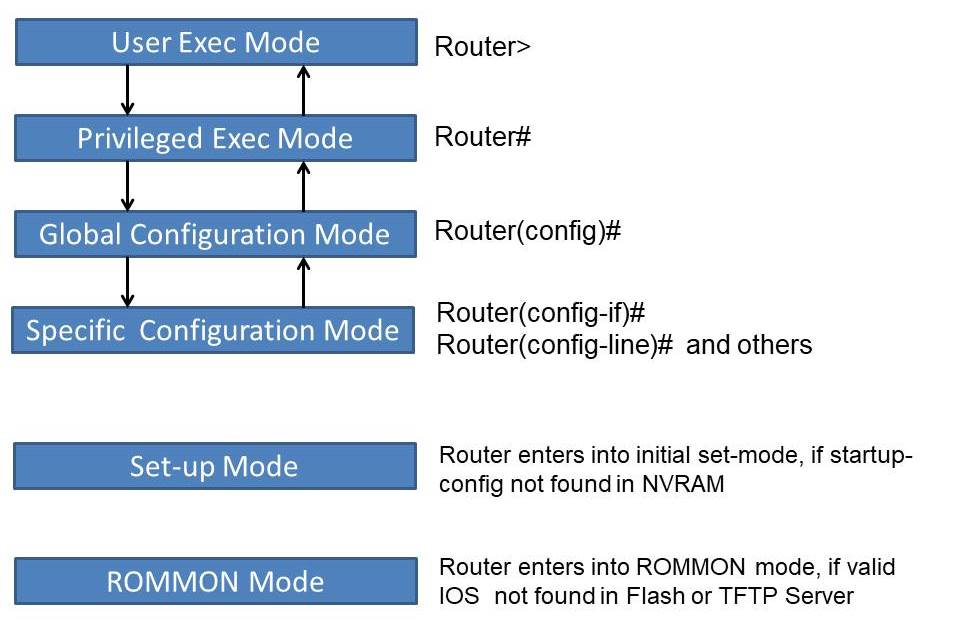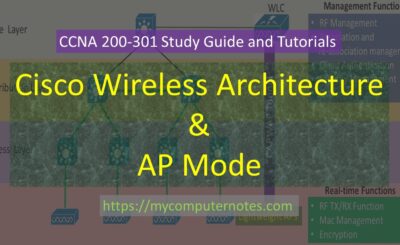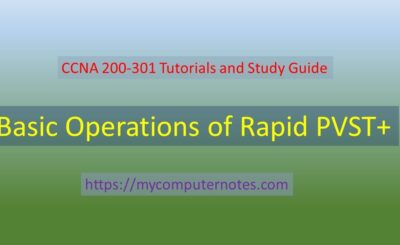In this article, we will discuss the different operating modes of a Cisco router.
The Cisco router works in a command-line interface. It employs different operating modes or prompts to execute various CLI commands.
Different Modes of a Cisco Router
The various command modes supported by a Cisco router are as follows:
- User Exec Mode
- Privileged Exec Mode
- Global Configuration Mode
- Specific Configuration Mode
- Setup Mode
- ROMMON Mode

User Exec Mode
As soon as the router is turned on, it starts decompressing the IOS image to the RAM and we gain access to the router command-line interface. After the booting process is completed, and we press Enter, the router enters into User Exec mode with User prompt.
| Router> |
The User Exec mode can execute a few show and network commands like tracert, ping, telnet, etc.
Privileged Exec Mode
The privileged mode is the next level of router mode. To go to the privileged mode, we have to type ENABLE command in User Exec mode and then hit Enter. Here, the command line prompt changes to #.
| Router> ENABLE
Router# |
The privileged mode supports various show commands like show version, show running-config, show startup-config, show IP interface brief, etc., and the write command to copy files from one memory to other types of memory in a router. Mostly, privileged mode commands are used for troubleshooting purposes.
The router is password protected with Enable Password and Enable Secret Password to move from User Exec mode to Privileged Exec mode.
You can find details of the different types of passwords in a Router on another topic:
Global Configuration Mode
When we type CONFIGURE TERMINAL or config t in privileged mode, we will enter into the Global Configuration mode.
All the configuration commands that affect the running configuration of the router are executed in global config mode. They are called global commands. The commands for naming the router, setting different passwords, IP route commands, etc. are the global commands.
| Router>ENABLE
Router# CONFIG T Router (config)# |
Specific Configuration Mode
The Specific configuration mode is the sub-mode of the global config mode. If we want to enter into a specific interface and configure that interface working parameters, we have to go into the Interface mode. To go into the Interface mode from the global mode, we have to enter the following command (In the following example, serial interface 0/0/0 is taken)
| Router>ENABLE
Router# CONFIG T Router (config)# INTERFACE SERIAL 0/0/0 Router(config-if)# |
The various other specific modes available for a Cisco router are:
- Sub-Interface Mode: Router(config-subif)#
- Line Mode: Router(config-line)#
- Router Mode: Router(config-router)#
Set-up Mode
Router jumps into the initial set-up mode when it does not find any startup configuration in NVRAM. In this case, the router displays the following screen:
If we want to skip the setup mode, we have to type NO and hit the ENTER key. The router then will enter into User Exec mode.
ROMMON Mode
This is the case when the router does not boot in normal mode. It happens, when the router does not find the valid IOS image in flash memory or TFTP server. In this situation, the router is forced to boot from bootstrap code. This is called the ROMMON mode. ROMMON mode helps to diagnose and troubleshoot the router.
The configuration Register value stored in NVRAM indicates that the router boots in normal mode or ROMMON mode. When the value of the configuration register is 0x2142, then the router is in ROMMON mode.
| rommon 1> |
The table below shows different modes of the router, their prompts, and how to enter into and exit from a particular mode:
| Modes | Prompts | How to enter into a particular mode | Exit from the mode |
| User Execution Mode | Router> | After, the router boots in default mode hit the ENTER key. | Type EXIT in User Exec Mode
Router>EXIT |
| Privileged Execution Mode | Router# | Type ENABLE command in user mode to enter into the privileged mode
Router>ENABLE |
Type DISABLE to go back to User mode.
Router#DISABLE Type EXIT to log out of the router Router#EXIT |
| Global Configuration Mode | Router(config)# | Type CONFIGURE TERMINAL command in privileged mode to enter into global config mode
Router#CONFIGURE TERMINAL |
Type EXIT to back to the previous mode i.e. privileged mode
Router(config)#EXIT |
| Specific Configuration Mode |
& others |
For interface mode, type Interface <port ID> in global config mode. For example:
Router(config)#INTERFACE Serial 0/0/0 Example for line mode: Router(config)#LINE CONSOLE 0 Example for router mode: Router(config)# ROUTER RIP |
Type EXIT to go back to a previous mode or type END to go directly into privileged mode.
|
| Set-up Mode | Router Parameter <parameter Value>: | Router enters into the set-up mode, when it does not find the startup-config in NVRAM. | Type NO to exit from the set-up mode to get back to the user mode. |
| ROMMON Mode | rommon 1> | When you are in privileged mode, type RELOAD command and as the router starts rebooting, immediately press CONTROL +C key to enter into the ROMMON mode
Router#RELOAD |
Type RESET command to go back to the usual mode
rommon 1>RESET |
| ←Prev | Next→ | |
| Router and its Major Components | Cisco IOS Basic Commands |





